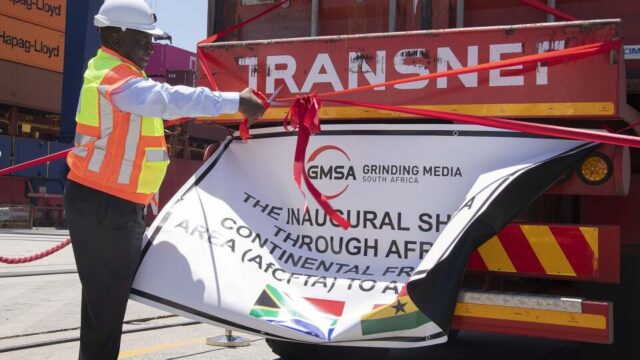OPINION: The African Continental Free Trade Area Agreement will help because it will lower the import duties if the product is made in Africa, giving African manufacturers a relative advantage to countries outside the continent, writes Donald MacKay.
By Donald MacKay
ON JANUARY 31, 2024, South Africa exported its first shipment of goods to Ghana under the African Continental Free Trade Area Agreement (AfCFTA). It was very exciting. The president and his ministers, wearing traffic cop fluorescent vests and hard hats, looked ready to actually load the containers themselves onto the MSC Floriana VI.
Inside the containers were fridges and home appliances (it’s not true that these were being exported because they are electrical appliances, and we have no electricity). There was also some mining equipment. This was being done under the Guided Trade Initiative (GTI), which allows countries to get a feel for the AfCFTA export experience by sending small quantities of stuff between the signatory states.
This is an important agreement for Africa because Africa hardly trades with itself. There is little trade complementarity (a fancy word for making the stuff you want to buy).
Most African countries produce minerals and few of them manufacture much else. Most Africans don’t want to buy rocks, though, and so lots of stuff is imported. Imported things tend to be more expensive because you have to add lots of costs to the iron ore to turn it into a fridge.
This means that, ultimately, most African states import more than they export, leaving them perpetually short of foreign exchange to pay for the imports. By manufacturing more, they would need to import less and so this problem would diminish. This is the theory. The reality is a lot more complex.
Even if lots of things get made in Africa, this doesn’t mean African people will want to buy it. For instance, South Africa makes lots of clothing, but many South Africans prefer imported clothing.
Governments attempt to get people to realise the error of their ways by imposing import duties (imported clothing carries a 45% premium) or placing other barriers in place to make it difficult to import, but this has the effect of taking money out of consumers’ wallets and leaving them with less to spend on other stuff. It also incentivises companies to not export. After all, why would you want to export when you can sell locally at a 45% premium?
To get more things made in Africa, a very important goal, Africa has to be a competitive manufacturer, and this is a hard nut to crack. The trade agreement will help because it will lower the import duties if the product is made in Africa, giving African manufacturers a relative advantage to countries outside the continent, but this also means African states will collect less revenue.
In South Africa, about 3.8% of our total revenue is customs duties. But in countries like Uganda, where border taxes account for more than 23.4% of their total revenue pool, this is a big problem. To deal with this, the agreement creates an adjustment fund, which countries with the border tax problem, can access to help offset the lower revenues they will collect.
This is essential, but not sufficient. Africa has a massive geographical disadvantage to most of the rest of the world. It has no navigable waterways from the sea and even for intra-African trade, its rivers are well-nigh impossible to navigate for any distance.
Water transport is, by a very large margin, the cheapest way of moving cargo. A study by the Maritime Executive found water transport to be 20% of the price of rail, the second cheapest mode of transport. Rail is around half the price of road transport, so you can see how important it is to have low-cost transport systems in Africa to be competitive.
For the agreement to work, it has to overcome the very large hurdle of internal transport costs. We can’t easily make the rivers navigable, but Africa can invest in rail, which would make an enormous difference. Not just the colonial railway systems from the mine to the port, but between countries. A huge portion of Africa is landlocked and for these countries, rail is incredibly important.
South Africa also implemented some of the AfCFTA on January 31, to coincide with the first export. This means that companies wishing to import from Algeria, Cameroon, Egypt, Ghana, Kenya, Rwanda, and Tunisia, can now do so and pay the lower duty provided for in the AfCFTA.
Rules of origin do apply though, so don’t assume just because it came from one of these countries that you will get the duty preference. Rule of origin exist in all trade agreements to avoid a situation where someone in Ghana buys shirts from India, sews on the Made in Ghana label and benefits from the agreement. These are complicated. If you intend importing from these seven countries, you need to be sure you understand rules of origin well, or you are being advised by someone who does.
Trade with the Southern African Customs Union and with the SADC will continue as before, unaffected by the new developments.
This is a good moment and I hope we soon begin seeing much more trade with the rest of the continent.
* Donald MacKay is the founder and CEO of XA Global Trade Advisors. He has been advising both local and foreign companies on global trade issues for over two decades.
– BUSINESS REPORT








